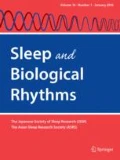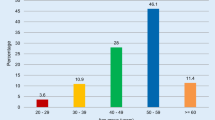Abstract
Electronic media are widespread and research has revealed connections between media use and sleep loss. In this study we aimed to elucidate how many media users get insufficient sleep and whether lengthy media use before sleep curtails sleep. Registered monitor members were surveyed twice on the Internet. The prevalence of self-perceived insufficient sleep ascribed by respondents to using electronic media before sleep was 48.0% (first survey) and 45.0% (second survey). Younger respondents more frequently ascribed using media before sleep as a factor in their perceived insufficient sleep than older respondents. After excluding respondents who ascribed their perceived insufficient sleep to factors other than the electronic media, the sleep duration before a workday was 6.38 ± 1.04 h for light media users (<2.5 h) before sleep, 6.20 ± 1.10 h for intermediate users (=2.5 and <3.5 h) and 6.22 ± 1.09 h for heavy users (=3.5 h). A Scheffe analysis revealed a significant difference between the light users and medium users (P = 0.02), and between light users and heavy users (P = 0.03). Only 29.0% of light users perceived they had insufficient sleep compared to 53.5% of heavy users. Users who perceived they had insufficient sleep reported a greater disparity in their sleep duration before workdays compared with that before non-workdays (P < 0.001) and a greater disparity between their perceived sufficient sleep hours and their actual sleep time before workdays (P < 0.001). There was a significant difference in disparity between perceived sufficient sleep and actual sleep time before workdays among media use groups (P = 0.002). Because half the respondents ascribed insufficient sleep to using electronic media, attention should be given to media use before sleep as a cause of perceived insufficient sleep.
Similar content being viewed by others
References
Internet Association Japan. Part II: personal use trend. In: Nishikido Y, Agarie M, Kunii A eds. Internet White Paper. Impress R&D: Tokyo, 2006; 51–162.
Dentsu Communication Institute Inc. Part I: trend of information media industry. In: Fujii Y, Sekiguchi T, Wada M et al. eds. A Research for Information and Media Society. Diamond Inc: Tokyo, 2006; 32–207.
Dentsu Communication Institute Inc. Part III: data related to information media. In: Fujii Y, Sekiguchi T, Wada M et al., eds. A Research for Information and Media Society. Diamond Inc: Tokyo, 2006; 236–67.
American Academy of Sleep Medicine. III Hypersomnias of central origin. In: Sateria M ed. International Classification of Sleep Disorders: Diagnostic and Coding Manual, 2nd edn. American Academy of Sleep Medicine, Westchester, IL, 2005; 79–115.
Ohayon MM. Epidemiology of insomnia: what we know and what we still need to learn. Sleep Med. Rev. 2002; 6: 97–111.
Weissbluth M, Poncher J, Given G, Schwab J, Mervis R, Rosenberg M. Sleep duration and television viewing. J. Pediatr. 1981; 99: 486–8.
National Sleep Foundation. Sleep in America Poll. The Foundation: Washington, DC, 2000.
Cajochen C, Krauchi K, Danilenko KV, Wirz-Justice A. Evening administration of melatonin and bright light: interactions on the EEG during sleep and wakefulness. J. Sleep Res. 1998; 7: 145–57.
Higuchi S, Motohashi Y, Liu Y, Maeda A. Effects of playing a computer game using a bright display on presleep physiological variables, sleep latency, slow wave sleep and REM sleep. J. Sleep Res. 2005; 14: 267–73.
Higuchi S, Motohashi Y, Liu Y, Ahara M, Kaneko Y. Effects of VDT tasks with a bright display at night on melatonin, core temperature, heart rate, and sleepiness. J. Appl. Physiol. 2003; 94: 1773–6.
Owens J, Maxim R, McGuinn M, Nobile C, Msall M, Alario A. Television-viewing habits and sleep disturbance in school children. Pediatrics 1999; 104: e27.
Buckingham D. Moving Images: Understanding Children’s Emotional Responses to Television. Manchester University Press: Manchester, 1996.
Honda N, Motokawa A. Can internet surveys be used for social surveys?: results of an experimental study. JILPT Res. Rep. 2005; 15: 1–26.
Nihon Shinbun Kyoukai kouhou iinnkai. kaku media no sessyoku jyoukyou. In: Murakami B, Tsuburaya H, Komiyayama H likeyayama H, upply their names. eds. Zenkokku Media Sessyoku/Hyouka Cyousa. Nihon Shinbun: Tokyo, 2003; 39–54.
Statistics Bureau & Statistical Research and Training Institute. 11. Information and communication/science and technology. In: Etoh H ed. Japan Statistical Yearbook. Statistics Bureau Ministry of Internal Affairs and Communications: Tokyo, 2006; 363–7.
Dentsu Communication Institute Inc. Part VII: trend on popularization on internet over the world. In: Fujii Y, Sekiguchi T, Wada M eds. A Research for Information and Media Society. Diamond Inc: Tokyo, 2006; 236–7.
Shanahan TL, Czeisler CA. Physiological effects of light on the human circadian pacemaker. Semin. Perinatol. 2000; 24: 299–320.
Yasukouchi A, Ishibashi K. Non-visual effects of the color temperature of fluorescent lamps on physiological aspects in humans. J. Physiol. Anthropol. Appl. Hum. Sci. 2005; 24: 41–3.
Drennan M, Kripke DF, Gillin JC. Bright light can delay human temperature rhythm independent of sleep. Am. J. Physiol. 1989; 257: R136–41.
Hashimoto S, Nakamura K, Honma S, Tokura H, Honma K. Melatonin rhythm is not shifted by lights that suppress nocturnal melatonin in humans under entrainment. Am. J. Physiol. 1996; 270: R1073–7.
Lewy AJ, Sack RL, Miller LS, Hoban TM. Antidepressant and circadian phase-shifting effects of light. Science 1987; 235: 352–4.
Minors DS, Waterhouse JM, Wirz-Justice A. A human phase-response curve to light. Neurosci. Lett. 1991; 133: 36–40.
Higuchi S, Motohashi Y, Maeda T, Ishibashi K. Relationship between individual difference in melatonin suppression by light and habitual bedtime. J. Physiol. Anthropol. Appl. Hum. Sci. 2005; 24: 419–23.
Zeitzer JM, Dijk DJ, Kronauer R, Brown E, Czeisler C. Sensitivity of the human circadian pacemaker to nocturnal light: melatonin phase resetting and suppression. J. Physiol. 2000; 3: 695–702.
Cajochen C, Dijk DJ, Borbely AA. Dynamics of EEG slow-wave activity and core body temperature in human sleep after exposure to bright light. Sleep 1992; 15: 337–43.
Dijk DJ. Circadian variation of EEG power spectra in NREM and REM sleep in humans: dissociation from body temperature. J. Sleep Res. 1999; 8: 189–95.
Kozaki T, Kitamura S, Higashihara Y, Ishibashi K, Noguchi H, Yasukouchi A. Effect of color temperature of light sources on slow-wave sleep. J. Physiol. Anthropol. Appl. Hum. Sci. 2005; 24: 183–6.
Boivin DB, Duffy JF, Kronauer RE, Czeisler CA. Dose-response relationships for resetting of human circadian clock by light. Nature 1996; 379: 540–2.
Cajochen C, Zeitzer JM, Czeisler CA, Dijk DJ. Dose-response relationship for light intensity and ocular and electroencephalographic correlates of human alertness. Behav. Brain Res. 2000; 115: 75–83.
Author information
Authors and Affiliations
Corresponding author
Additional information
The source(s) of support in the form of grants: this study was supported by the Health Promotion Foundation as a grant of 500 000 yen.
Rights and permissions
About this article
Cite this article
Suganuma, N., Kikuchi, T., Yanagi, K. et al. Using electronic media before sleep can curtail sleep time and result in self-perceived insufficient sleep. Sleep Biol. Rhythms 5, 204–214 (2007). https://doi.org/10.1111/j.1479-8425.2007.00276.x
Received:
Accepted:
Published:
Issue Date:
DOI: https://doi.org/10.1111/j.1479-8425.2007.00276.x



